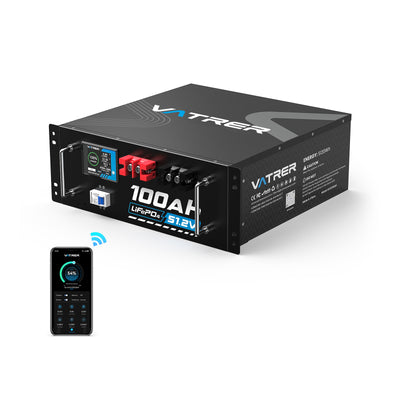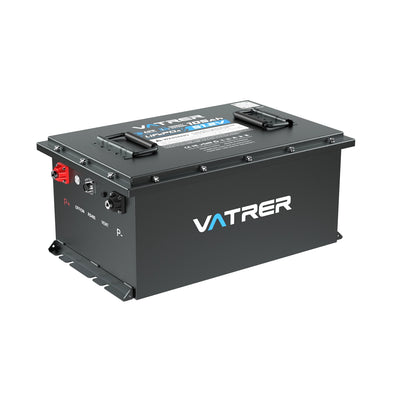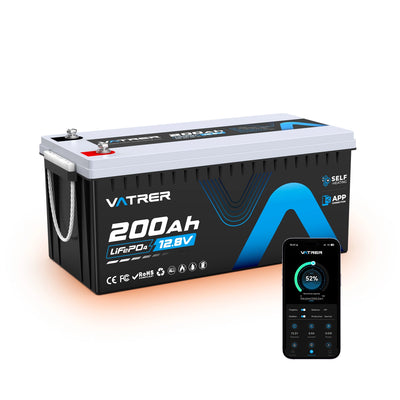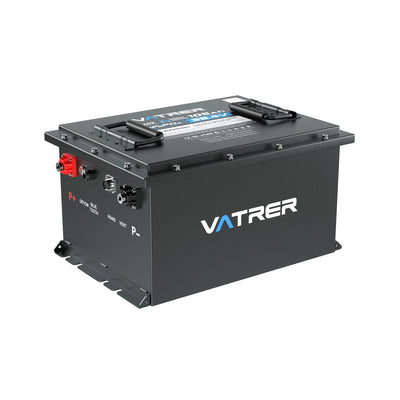
How Long Do Deep Cycle Batteries Last?
Fed up with having to change batteries every few years in your solar installation or motorhome? If you’re wondering how long a deep cycle battery can realistically last, it’s worth knowing that these batteries are the backbone of steady power for boats, off-grid systems and marine equipment – but their service life is heavily influenced by chemistry, usage patterns and day-to-day care.
In this overview, we’ll look at the main factors that determine lifespan and share practical advice to help you select and look after a battery properly. Doing so can help you avoid unexpected costs and enjoy dependable performance over many years.
What Is a Deep Cycle Battery and Why It Matters for Longevity?
A deep cycle battery is designed to deliver a continuous flow of power over an extended period, coping with repeated discharge and recharge cycles while losing far less capacity than a conventional starter battery, which is built to provide a brief, high-current surge to start an engine. This makes deep cycle designs ideal wherever you need sustained energy, for example to run appliances in a caravan or store electricity from solar panels.
They are commonly used in solar energy storage banks, UPS backup systems, boats with trolling motors, golf carts, electric drive systems and remote homes. Typical technologies include flooded lead-acid batteries, gel batteries, AGM batteries and newer lithium-ion choices such as LiFePO4.
Lithium-based batteries usually offer higher energy density and better efficiency, so they can be discharged more deeply without damage. This capability often results in a longer overall lifetime than traditional lead-acid batteries, which need more cautious operation to prevent premature wear.
Still unsure how deep cycle batteries differ from standard batteries? Have a look here: What are deep cycle batteries?

Exploring How Long Deep Cycle Batteries Last by Type
On average, deep cycle batteries last somewhere between 3 and 10 years or more, but lifespan is better described in charge–discharge cycles, where one cycle means a full charge followed by a full discharge. Depth of discharge (DoD) is crucial here: limiting discharge to around 50% can roughly double the cycle count compared with regularly draining to 90%, because shallow cycling places far less stress on the cells.
Standard lead-acid deep cycle batteries typically deliver about 300–500 cycles, whereas lithium technologies perform far better. For example, in a motorhome where the battery is cycled daily to power lighting and appliances, a lithium RV battery can maintain more stable voltage and output and may last three to five times longer than a comparable lead-acid unit in real-world use.
To make things easier to compare, the table below shows typical performance differences between common deep cycle battery types:
| Type of Battery | Typical Lifespan (Years) | Charge-Discharge Cycles | Depth of Discharge (Recommended) | Maintenance Level |
|---|---|---|---|---|
| Flooded Lead-Acid | 3-5 | 300-500 | 50% | High |
| Gel | 4-7 | 500-1,000 | 50-70% | Medium |
| AGM | 4-7 | 500-1,000 | 50-80% | Low |
| Lithium (LiFePO4) | 8-10 | 2,000-5,000 | 80-100% | Very Low |
Because lithium deep cycle batteries use lithium iron phosphate chemistry, they provide more stable, safer operation and their useful life is considerably longer than most alternative technologies.
If you need a dependable lithium battery for camping or touring in your motorhome, the Vatrer 12V deep-cycle battery is a strong candidate. For further details on RV deep cycle batteries, you can also read: What's the Best Deep-Cycle Battery for RVs?
Key Factors That Affect the Lifespan of a Deep Cycle Battery
Quoted lifespans for different battery types are only guidelines. How long a particular battery lasts also depends heavily on how and where it is used. Below are the main influences on the life expectancy of deep cycle batteries. Spotting these issues early allows you to adjust your routine and reduce the risk of premature failure.
Maintenance Practices: Good maintenance is fundamental. With flooded lead-acid batteries, regularly check electrolyte levels so that the plates never become exposed, which would cause irreversible damage, and keep terminals clean to prevent corrosion and poor contact. AGM and gel batteries require less frequent attention but still benefit from occasional checks. Lithium batteries simplify things further thanks to an integrated battery management system (BMS), which automatically protects against common faults, reducing user error and helping to prolong service life.
Tip: Put a reminder in your calendar once a month to carry out basic checks and catch small issues before they shorten lifespan.
Temperature Conditions: Both heat and cold impact the electrochemistry inside the battery. As a rule of thumb, every 10°C rise above 25°C (77°F) can shorten lifespan by around 20–50% because ageing reactions speed up, whilst low temperatures mostly reduce available capacity temporarily without causing as much permanent damage. For optimum results, try to keep batteries in the 50–77°F (10–24°C) range. In harsher climates, insulated boxes or temperature-controlled storage can help maintain stable performance.
Operating Environment: The physical environment around the battery also matters. Provide adequate ventilation, particularly with lead-acid batteries, to disperse hydrogen and oxygen produced when charging. This reduces the risk of gas build-up and promotes safer, longer operation. Poor airflow can encourage overheating or corrosion, so install batteries in dry, well-ventilated areas away from damp or heavy dust.
Usage Patterns: The way you draw power from the battery has a direct effect on ageing. High current loads, frequent deep discharges or very high DoD can all accelerate wear by placing extra strain on the cells. In lead-acid batteries, this often results in sulphate crystals forming on the plates, which increases internal resistance and permanently reduces capacity. Lithium batteries cope better because the BMS monitors and manages many of these stresses, keeping performance more consistent.
Tips: Use a battery monitor to understand your loads and aim for moderate discharges where possible to balance energy availability and lifespan.
Battery Quality and Design: Battery quality varies widely. Higher-grade products use better materials and more robust construction, so they withstand mechanical and electrical stress more effectively. Budget units may be cheaper at purchase but can fail sooner under the same conditions. When selecting a battery, favour recognised brands that back their products with warranties linked to cycle counts, such as Vatrer Battery, as this usually reflects a more durable design.
Considering an upgrade or full replacement of your bank? Vatrer deep-cycle batteries all include integrated BMS and low-temperature protection. They are available in a wide range of capacities and formats, including self-heating versions. Whether you are powering a motorhome, an electric golf cart or a solar installation, there is likely to be a model that suits your requirements.
Practical Tips on How to Extend the Lifespan of Deep Cycle Batteries
Once you understand the main influences on deep cycle battery life, you can apply specific measures to keep them running longer, very much like carrying out preventative maintenance on any other critical power equipment. Below are some straightforward tips you can start using straight away:
Proper Charging Techniques: Always use a charger matched to the particular battery chemistry to avoid overcharging or chronic undercharging, both of which gradually damage the cells.
For lead-acid batteries, carry out an equalisation charge every 1–3 months. This helps balance the voltage between cells and reduces sulphation. Connect the charger and follow the manufacturer’s equalisation settings for a controlled overcharge.
Lithium batteries charge faster and more efficiently, often reaching full charge in around half the time of lead-acid. However, avoid using a conventional lead-acid charger, as the charge profile is different and may cause incomplete charging or, in the worst case, damage.
Tip: Consider a Vatrer smart charger with automatic cut-off for safer, largely hands-free charging.
Routine Maintenance and Inspections: Regular inspection is one of the simplest ways to catch faults early. Check battery terminals every month for corrosion and clean them using a baking soda and water solution plus a wire brush to maintain strong electrical connections.
For flooded lead-acid batteries, also check electrolyte levels and top up with distilled water if needed, ensuring the plates remain covered to prevent drying out and capacity loss. Always do this after charging so the electrolyte is properly mixed and won’t overflow.
AGM and gel units are sealed and require only minimal attention, whilst lithium batteries are practically maintenance-free thanks to the BMS.
Tips: Keep a simple maintenance record so you can identify recurring issues and deal with them before they become serious.
Optimal Storage Practices: Correct storage when the battery is not in regular use slows degradation. Aim to leave the battery at around 50–70% state of charge rather than fully flat, and store it in a cool, dry, ventilated place away from direct sun or freezing conditions. Ideal storage temperatures are around 50–77°F (10–25°C).
If the battery will be idle for more than a few months, recharge it periodically to offset self-discharge. Lithium batteries usually self-discharge at only about 1–3% per month, while lead-acid can lose up to 15%. For longer storage, disconnect the terminals to prevent small parasitic loads from draining the battery.
Tips: A battery maintainer or trickle charger is useful for long lay-ups, as it keeps the battery topped up without overcharging.
Monitoring and Usage Alignment: Active monitoring helps you keep usage within sensible limits. Many lithium batteries come with smartphone apps or Bluetooth monitors that display live data such as voltage, temperature and cycle count, making it easier to spot unusual behaviour early.
For all chemistries, try to stay within the recommended depth of discharge: roughly 50% for lead-acid and up to 80–100% for lithium. Use a multimeter or dedicated battery monitor to understand your actual loads and adjust habits – for instance, running high-draw appliances in shorter bursts rather than continuously.
Tips: Using real-time data to guide how you use the system can increase battery life by 20–30%, particularly in variable environments like solar, boating or off-grid cabins.
Have a look at Vatrer solar batteries and marine lithium batteries, or our wider range of deep cycle batteries for other applications. All Vatrer batteries support Bluetooth connectivity so you can check status in real time. For golf cart batteries, we also provide an external display for dual monitoring.
Conclusion
To sum up, deep cycle battery lifespan varies considerably by technology. Lithium LiFePO4 batteries typically offer around 8–10 years and 2,000–5,000 cycles, whereas lead-acid options average 3–5 years, with both strongly influenced by maintenance, ambient temperature and usage patterns. Paying attention to correct charging and a suitable operating environment can extend life significantly.
For anyone planning an upgrade, Vatrer lithium deep cycle batteries provide features such as integrated BMS for overcharge, over-discharge, over-current, short-circuit and low-temperature protection, rapid charging with high efficiency, lightweight construction for easier handling in motorhomes or boats, IP65 water resistance and A-grade cells rated for 4,000+ cycles. Reviewing your current system and exploring the Vatrer deep cycle battery range can help secure longer-lasting, more reliable power.
For more background on deep cycle batteries, you may find the following helpful:
What is a 12V deep-cycle battery?
Can the LiveScope be used with deep-cycle batteries?
What are the main uses of deep-cycle lithium batteries?
FAQs
Is It Worth Switching From Lead-Acid To Lithium Deep Cycle Batteries?
Moving from lead-acid to lithium is often worthwhile if you value long-term economy and stable performance, as lithium batteries generally provide 8–10 years of life and around 2,000–5,000 cycles, compared with roughly 3–5 years and 300–500 cycles for many lead-acid units.
Although lithium usually costs two to three times more at the outset, it brings advantages such as lower weight (up to about 50% less), quicker charging and higher usable capacity without sulphation problems.
Over the years this translates into fewer replacements and lower maintenance costs. In a solar or motorhome system, for example, you could save several hundred euros or pounds over a decade by avoiding multiple lead-acid replacements. If your consumption is modest or your budget very limited, however, lead-acid may still be acceptable.
How Do I Know When To Replace My Deep Cycle Battery?
Common warning signs include noticeably shorter runtime (only holding 70–80% of the original capacity), slower or incomplete charging, swollen battery cases, or a 12V battery dropping below about 10.5V under load.
For lead-acid batteries, heavy sulphation or consistently low specific gravity readings (below about 1.225) usually indicate permanent damage. Lithium batteries may show BMS fault codes, repeated alarms or inconsistent app readings.
Most batteries are considered at end-of-life once capacity falls to roughly 80% of the original, which may occur after 300–500 cycles for lead-acid but 3,000 or more for lithium.
Regular checks with a multimeter or load tester help you identify this stage in good time.
Suggestion: carry out a capacity test every six months by discharging to the recommended DoD and then measuring how long it takes to recharge.
Can Deep Cycle Batteries Perform Well In Cold Weather, And How To Optimise Them?
Deep cycle batteries can operate in cold conditions, but performance inevitably drops. Below 32°F (0°C), available capacity may fall by 20–50% as chemical reactions slow. Lead-acid batteries are more vulnerable and can even freeze if not kept fully charged, whilst lithium tends to handle temperatures down to around -4°F (-20°C) better, particularly if fitted with heating elements.
Cold does not usually cause permanent damage if managed properly, unlike high heat. In winter marine or off-grid applications you should expect reduced runtime, sometimes as little as half of summer capacity.
Suggestion: use insulated battery enclosures or thermal wraps, and choose batteries with low-temperature cut-off or self-heating, such as selected Vatrer lithium models that activate heating below 32°F. Always try to charge in a milder environment and rely on a BMS with integrated temperature sensors to keep charging within safe limits.
How Long Do Deep Cycle Marine Batteries Last?
Deep cycle marine batteries for boats and trolling motors generally last around 3–6 years for flooded or AGM lead-acid types under typical use, giving roughly 300–1,000 cycles depending on care, vibration and exposure to moisture.
Lithium (LiFePO4) marine batteries can extend this to 8–10 years or more, with around 2,000–5,000 cycles, largely because they resist vibration and corrosion better in damp, salty environments.
Unmanaged saltwater exposure, poor mounting or constant over-discharge can shorten life, but regular rinsing of terminals and using housings with proper sealing can mitigate these issues.
For boats used very frequently, lead-acid batteries might need replacement every 2–3 years, whilst lithium could remain in service for five years or longer.
Suggestion: select marine-rated batteries with at least IP65 protection, such as a Vatrer marine lithium battery, and check capacity annually with a hydrometer (for lead-acid) or multimeter to predict failures early and avoid breakdowns on the water.
How Long Can a Deep Cycle Battery Last Without Charging?
How long a deep cycle battery can go without charging depends on whether it is supplying a load or just in storage. Under a constant 10A load, for example, a 100Ah battery might run for around 10 hours before reaching a deep discharge, although lithium will maintain a steadier voltage during that time.
When idle with no load, a healthy battery can often hold a useful charge for up to six months. This is due to low self-discharge rates – typically 1–3% per month for lithium and 5–15% for lead-acid. However, prolonged storage whilst fully discharged or in very hot conditions can cause sulphation or permanent capacity loss.
Suggestion: for storage, leave the battery at about 50–70% charge and connect a maintenance charger every few months to top it up gently. Check voltage with a meter (aim to keep a 12V battery above roughly 12.4V) and consider low self-discharge lithium models from Vatrer for seasonal uses, such as caravans or holiday homes, where long idle periods are common.
Share



















































